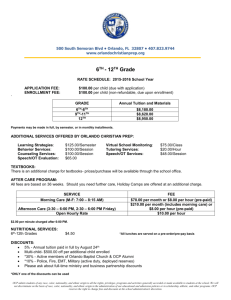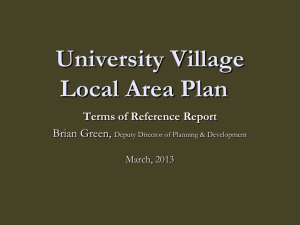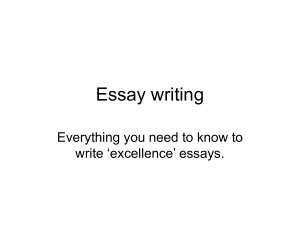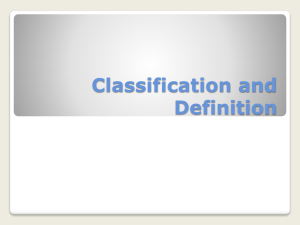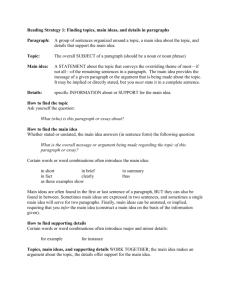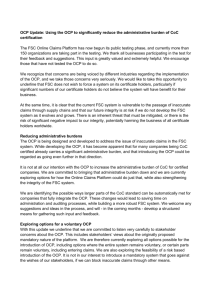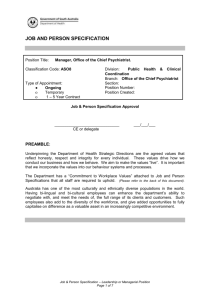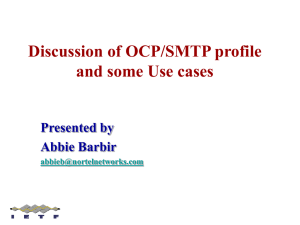Literacy Activity
advertisement
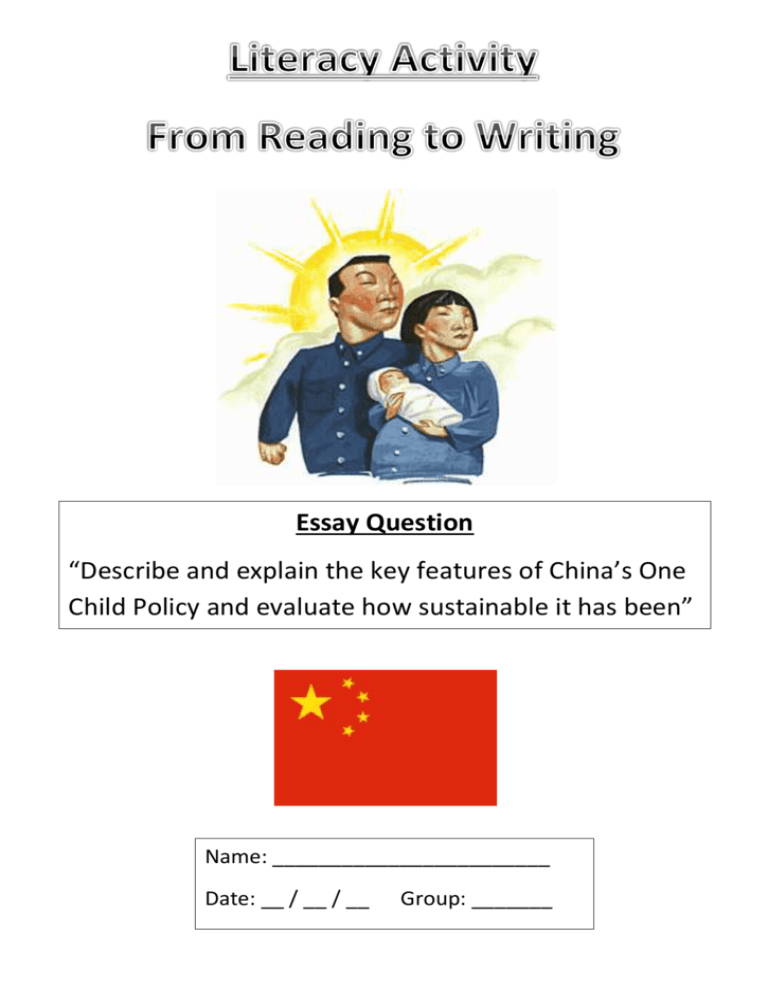
Essay Question “Describe and explain the key features of China’s One Child Policy and evaluate how sustainable it has been” Name: ________________________ Date: __ / __ / __ Group: _______ Activation of Prior Knowledge Task – Complete the mind map activity to identify what you already know about the following topics for China: Country facts Culture Population Physical Geography Population distribution Changes in country over time Communism Population control o OCP o Why? o Rules o Why wrong? o How did it work? What do I already know about China and their One Child Policy? Establishing purposes You will need to find out more information about China as part of this research project. What do you want to know? Why? Where will you look for it? (see the example done for you) What do I want to find out? How will this information help? Who was the person who introduced This will help me to introduce the the One Child Policy? One Child Policy Where will I look for this information? Internet - Wikipedia Reading strategy There are different types of reading strategy that you may need to use when completing your research: Technique Skimming Continuous Scanning How it is used? Allow your eyes to glance quickly over a page taking note of: Title – shortest summary of article Read opening paragraph – often summarises article Read headings and first sentences of each paragraph Look for keywords, bold words, summary boxes Read the last paragraph - conclusion Reading a piece of text from start to finish You read every word in order Looking over an article very quickly for a specific piece of information by: Looking for a keyword Anticipating how it might appear – diagram, quote etc Skimming the article to see if a heading or opening sentence leads you to the information Skip over irrelevant sections When you find the relevant sentence, read it all Where is this useful? Have a practice at using these techniques on the following: In the late 1970s, the Chinese government introduced a number of measures to reduce the country's birth rate and slow the population growth rate. The most important of the new measures was a onechild policy, which decreed that couples in China could only have one child. In 1950 the rate of population change in China was 1.9 per cent each year. If this doesn't sound high, consider that a growth rate of only 3 per cent will cause the population of a country to double in less than 24 years! Previous Chinese governments had encouraged people to have a lot of children to increase the country's workforce. But by the 1970s the government realised that current rates of population growth would soon become unsustainable. The one-child policy The one-child policy, established in 1979, meant that each couple was allowed just one child. Benefits included increased access to education for all, plus childcare and healthcare offered to families that followed this rule. Problems with enforcing the policy: Those who had more than one child didn't receive these benefits and were fined. The policy was keenly resisted in rural areas, where it was traditional to have large families. In urban areas, the policy has been enforced strictly but remote rural areas have been harder to control. Many people claim that some women, who became pregnant after they had already had a child, were forced to have an abortion and many women were forcibly sterilised. There appears to be evidence to back up these claims. Impact of the policy The birth rate in China has fallen since 1979, and the rate of population growth is now 0.7 per cent. There have been negative impacts too - due to a traditional preference for boys, large numbers of female babies have ended up homeless or in orphanages, and in some cases killed. In 2000, it was reported that 90 per cent of foetuses aborted in China were female. As a result, the gender balance of the Chinese population has become distorted. Today it is thought that men outnumber women by more than 60 million. Reading task Read the articles provided and take notes using the recording table below: Name of Source (Source Type) Date Research Notes (key facts and how they will help you with your investigation) Questions to consider about source Name of Source (Source Type) Date Research Notes (key facts and how they will help you with your investigation) Questions to consider about source Name of Source (Source Type) Date Research Notes (key facts and how they will help you with your investigation) Questions to consider about source Features of discursive writing You are going to use your research information to produce a piece of discursive writing. There are three basic structures (ways of organising) for the discursive essay you argue strongly for a given discussion topic you argue strongly against a given discussion topic you argue about a given discussion topic in a balanced way. The following basic structure should be employed for writing this essay. Provide an interesting introduction. Provide background information on the topic so the reader understands the context of the essay State which argument you feel most strongly about but also make it clear that there are two-sides to this argument. You will write about the one you feel strongly about first: Present your first argument, with supporting evidence. Present your second argument, with supporting evidence. Present your third argument, with supporting evidence. Present your fourth argument, with supporting evidence, and so on (the number of paragraphs like this will depend on the number of arguments you can offer). Indicate, in a single paragraph or more, that there is another side to this argument, with some idea of the points likely to be made for the view(s) which are opposite to your own. Provide a clear indication of your position, your stance in relation to the topic (are you 'for' or 'against' ?) and conclude your essay. The opening of an essay is important. It should capture the reader's attention in some way or another. It should avoid being bland or dull. It should invite the reader to read on and create a sense of interest. If the beginning is flat, it will not inspire your audience. Methods of Opening a Discursive Essay Provocative - e.g. “It is difficult to see how anyone can approve of fox hunting." Balanced - e.g. “Fox hunting is a subject about which people hold strongly contrasting views." Quotation - e.g. “Oscar Wilde once described fox hunting as 'The unspeakable in pursuit of the uneatable.'." Illustration - e.g. “On a glorious autumn morning a terrified, exhausted animal is savaged to death by a pack of baying dogs while a group of expensively dressed humans encourage the dogs in their bloody work." Anecdote - e.g. “I have always detested fox hunting since I was almost physically sick while watching a television film of the kill at the end of a hunt." Connectives Any well-written piece of discursive writing will flow as one continuous piece despite being made up of three or four different arguments. One of the techniques which can help you to achieve this effectively is the use of linking words. These words are used at the beginning of a new paragraph or to link ideas within a paragraph. Same line of thought - e.g. - and, firstly, secondly etc., next, furthermore, likewise, in addition, similarly, also, moreover. Conclusion/summary - e.g. - thus, therefore, consequently, accordingly, in retrospect, hence, in conclusion, in brief, as a result. Definite statement - e.g. - without question, without doubt, unquestionably, absolutely. Contrasting idea - e.g. - yet, on the other hand, nevertheless, however, although, conversely, otherwise, on the contrary. Further examples - because, for instance, since, for example, so that, despite the fact that, accordingly, although, if, though, unless. 1 A subject which always arouses strong feelings on both sides of the argument is the use of animals in medical research. I believe that, though this may have been necessary in the past, other ways can be developed to test drugs and, in the future, animals should not be used. 2 One of my main reasons for saying this is that living tissues can be grown in test tubes and new drugs can be tested on these. Computers can also be programmed to show how medicines will react in the human body. 3 Moreover, animals are not always like humans. They do not suffer from all human diseases, so scientists have to give them the illnesses artificially. The joints in rabbit legs are inflamed with chemicals to help research in rheumatism. These tests do not always work because animals do not react to drugs in the same way as humans. Aspirin, for example, damages pregnant mice and dogs, but not pregnant women. Arsenic, which is a deadly poison for humans, has no effect on sheep, while penicillin, which is so valuable to humans, kills guinea pigs. 4 In addition, I believe that animal experiments should not be used because of the unnecessary pain that they cause to animals. The government introduced new rules about the use of animals in experiments in 1986. Scientists claim that these rules safeguard animals because they state that discomfort must be kept to a minimum and that painkillers must be used where necessary and appropriate. Surely this means, however, that scientists can still decide not to use painkillers in the animal experiments because they do not consider them appropriate. The British Union against Vivisection claims that 75% of animals experimented on are given no anaesthetic. 5 In spite of the claims of some scientists about the effectiveness of animal research, the death rate in this country has stayed the same over the last thirty years. There is also more long-term sickness, even though greater numbers of animals are being used in research. 6 On the other hand, scientists claim that some experiments are so small, for example giving an injection, that painkillers are not needed. They also argue that experiments on animals have been very useful in the past. For instance, the lives of ten million human diabetics have been saved because of experiments with insulin on dogs. Dogs also benefited, as the same drug can be used on them. In fact, a third of medicines used by vets are the same as those used by doctors. 7 It is argued by researchers that the use of animals in experiments cannot be replaced by methods using living tissue which has been grown in test tubes. These tests do not show how the drugs work on whole animals and so they only have limited effectiveness. 8 Although I accept that some drugs can be used on animals and humans, this does not mean that they have to be tested on animals in the first place when alternative methods are available. Alternative methods do work. Various groups have been set up to put money into other ways of researching. For example the Dr. Hadwen Trust has shown how human cartilage can be grown in test tubes to study rheumatism. Similar research is being done into cancer and multiple sclerosis. Tests can be done on bacteria to see whether a chemical will cause cancer. There is even a programme of volunteer human researchers, where people suffering from illnesses offer to help in research. 9 In conclusion, I accept that animal experiments have brought great benefits in the past, but now money needs to be spent on developing other methods of testing drugs and medical procedures, so that the use of animals can be phased out altogether. Paragraph number Purpose Key questions to consider 1 Introduction What is China? Where is China? What is China like? What do you think of when you hear the word ‘China’? What is this essay going to be about? 2 Background information 3 One Child Policy What is China’s population like? Where do people live in China (population distribution)? How is population distribution linked to physical geography? Why has China’s population grown so fast? What problems has this caused for China? What is the One Child Policy (OCP)? When was the OCP introduced? Who introduced the OCP? Why was the OCP introduced? How does the OCP work? What rules were made for the OCP? Incentives offered? Point(s) made (big/little) Evidence Keywords Paragraph Purpose number Key questions to consider 4 What problems did the OCP cause in China? Arguments against Why have these problems been caused by the OCP? How can the impacts of the OCP be categorised? Social Economic Environmental Political Are the impacts shortterm or long-term? Are the impacts local, national or global? Who is affected? Which is the worst impact? Why? Which is the least worst impact? Why? Point(s) made (big/little) Evidence Keywords Paragraph Purpose number Key questions to consider 5 How has the OCP helped China? Arguments for Has the rest of the world benefitted from the policy? (see arguments against for ideas about classifying impacts) 6 Conclusion What is your opinion on the OCP? Why? How sustainable has the OCP been? (consider the long-term impact and the balance between social, economic and environmental) Who else would have an opinion on the OCP? Who would agree with you/disagree with you? What could the future solution be for China? Are there any other countries that have successfully controlled their population growth? Point(s) made (big/little) Evidence Keywords Opening your introduction Method Explanation Example Provocative An opening statement which provokes thought/gives opinion. e.g. “It is difficult to see how anyone can approve of fox hunting." Balanced An opening statement that shows there are two sides to the argument. An opening statement with an important quote from another source. An opening statement which conjures up an image in the mind of the reader linked to the topic. e.g. “Fox hunting is a subject about which people hold strongly contrasting views." e.g. “Oscar Wilde once described fox hunting as 'The unspeakable in pursuit of the uneatable.'." e.g. “On a glorious autumn morning a terrified, exhausted animal is savaged to death by a pack of baying dogs while a group of expensively dressed humans encourage the dogs in their bloody work." e.g. “I have always detested fox hunting since I was almost physically sick while watching a television film of the kill at the end of a hunt." Quotation Illustration Anecdote An opening statement involving a personal story related to the topic. Your ideas Writing techniques This school doesn’t have enough computers for us to be successful. First, many rooms don’t have any computers. This means we can’t research information. Also some ICT rooms don’t have enough PCs for each pupil so we have to share. Finally, as we don’t use PCs frequently, many of us don’t use them for communication. This slows us down. “BIG POINT, little point” When providing a case you can make one big point (highlight green) and then support this with 2-3 little points (highlight red). This means you develop the point you are making rather than jumping from one idea to another without any depth. The London 2012 Olympics were a great success for the local people. The unemployment rate was reduced by 4% due to the Olympics creating 5000 extra jobs in construction and services. The reduction in unemployment means more people are earning money and so their quality of life will have improved. They will also be taking fewer benefits from the government so this money can be invested in other areas such as school and hospitals for local people. “Point, Evidence, Explain (PEE)” After you have made a point (highlight red) you then support the thing that you have said with a piece of evidence (highlight orange). This proves your point. It can be a number, quote, fact etc. You then explain what your evidence shows and why it is important (highlight green). How does it support your point? One Child Policy Assessment – Improving your level Use this levels table for advice on how to improve the population assessment. Section Level 3 Level 4 Level 5 Level 6 Level 7 Section 1: The background Where is China? What are its population features? Why does China have problem with overpopulation? Simple description of where China is and its population problem. Detailed description of the geography of China using keywords like relief, environment, dense and sparse. Describes China’s population problem using dates. As L4 but also includes a detailed explanation of why China has a population problem. As L5 but also explains how China’s problems could have affected other places and what our country thought about it. Not applicable. Section 2: The One Child Policy How did the policy work? Was it successful? Simple but accurate description of the rules and regulations (3-4 examples). Detailed description of the rules and regulations. Uses 3-4 keywords (such as registration, birth certificate, spy, incentive) As L4 but also detailed explanation of how the rules and regulations worked. Explains whether the policy worked or not. As L5 but also detailed explanation of how the policy was used in different situations. Explains why other countries were in favour. Not applicable. Section 3: Was the OCP sustainable? Criticisms and problems Simple but accurate description of the problems caused by the policy. Detailed and accurate description of the problems caused by the policy (uses 3-4 pieces of evidence). Detailed and accurate explanation of why the policy caused such terrible problems (uses 34 pieces of evidence). As L5 but also shows how the rest of the world began to object to the policy and why. As L6 but also discusses the sustainability of the policy. Detailed summing up of the China project. Describes a way to help China. Detailed explanation of the findings of the China project. Gives a realistic method of helping China with its population problem. As L5 but also detailed explanation of why countries need to work together on population problems. Explains why their recommendation for helping China is more sustainable than the OCP. Section 4: Conclusion and Simple summing up of recommendations the China project. What do you think? How would you solve China’s problems sustainably? Population wordbox DISTRIBUTION, DENSITY, POSITIVE AND NEGATIVE FACTORS, RESOURCES, UNEVEN DENSELY, SPARSELY, URBAN, CONURBATION, RURAL, REMOTE, INACCESSIBLE, INFRASTRUCTURE POPULATION EXPLOSION, BIRTH RATE, DEATH RATE, INFANT MORTALITY RATE, INDUSTRIAL REVOLUTION MYTH, REALITY, PROPAGANDA, MIGRATION, RURAL-URBAN, SEASONAL, INTERNATIONAL PHYSICAL GEOGRAPHY, HUMAN GEOGRAPHY, LOCATION FACTORS OVERPOPULATION, COMMUNISM, POLICY, ONE CHILD POLICY, RESOURCES, FAMINE, PLAGUE, CONFLICT OCP, STRATEGY, SPY, REGISTRATION, PERMISSION, PATRIOT, CERTIFICATE, MONITORING, COERCION HUMAN RIGHTS, ABORTION, TORTURE, INFANTICIDE, PENSION, SUSTAINABLE SUMMARY RESOLUTION, DISABILITY, GENDER,

